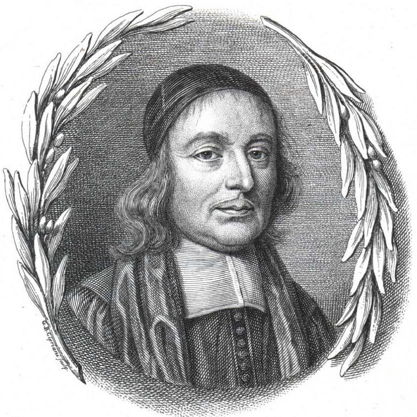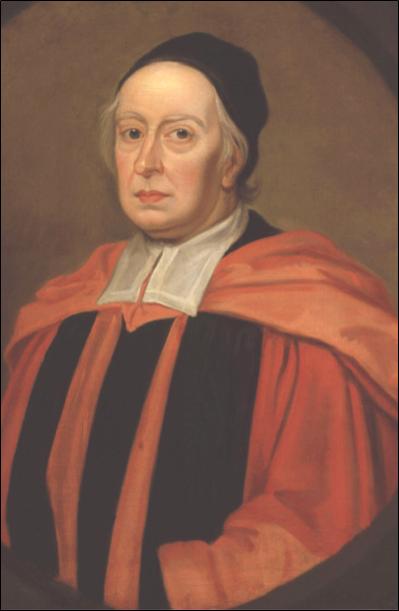Dr. John Wallis
For those not sure of the connection between John Wallis and the Blencowe Family, may I begin by stating that he was the father of Lady Anne Blencowe, the author of 'The Receipt Book of Lady Anne Blencowe' and the wife of Sir John.

Dr. John Wallis 1616-1703
John Wallis was born in 1616 in Ashford, Kent, where his father, the Rev John Wallis was a highly respected minister. He went to school in Ashford but an outbreak of the plague led his mother to move him to James Movat's Grammar school in Tenterden, where he showed great potential as a scholar. Still only 13, he rather arrogantly, reckoned himself fit for University as quoted from his autobiography: "I was as ripe for university as some who have been sent thither."
However he was not to go to Emmanuel, College, Cambridge till he was 16, but at Martin Holbeach School in Felsted, he became proficient in Latin, Greek and Hebrew. At Cambridge he studied ethics, geography, metaphysics, astronomy, medicine and anatomy and was one of the first to publicly debate the circulation of the blood.
The 17th Century Civil War was approaching and John Wallis's sympathies were with Parliament. Having received his Master's Degree and having been ordained, the first of two events took place which shaped his future.
One evening at supper with Parliamentary leaders, a letter in cipher was brought in relating to the capture of Chichester in 1642, which John Wallis was able to decipher in two hours. He was then recognised as a brilliant cryptographer, an art he exercised for Parliament, which also brought him to the attention of Oliver Cromwell. This decoding of royalist messages for Parliament would have hardly endeared him to his daughter's future husband, John Blencowe, who fought for the King at the Battle of Edgehill.
The second event was meeting the most brilliant scholars of the age, amongst whom were Robert Boyle, Christopher Wren, Sir Robert Moray, John Wilkins, Robert Hooke, John Evelyn, and later Isaac Newton. This enthusiastic group of scientists, interested in natural and experimental science, were the forerunners of the Royal Society of London formed in 1660. Wallis wrote a number of books on Mathematical studies and was appointed Savilian Professor of Geometry at Oxford University by Oliver Cromwell mainly for his support for the Parliamentarians.
Although Wallis was a Parliamentarian he certainly spoke out against the execution of Charles I, signing a document to try and prevent it, possibly with the encouragement of his wife, Susanna Glyde.
This stood him in good stead for, in 1660, when Charles II was restored to the throne, his appointment to the Savilian Chair was confirmed, he was appointed a Royal chaplain, and in 1661, was nominated as a member of a committee set up to revise the Prayer Book.

John Wallis was also involved in devising a system for teaching deaf-mutes. Although William Holder had claimed that he had taught a deaf man, Alexander Popham to speak 'plainly and distinctly and with a good and graceful tone', Wallis later claimed the credit for this, and if you read Douglas Bain's CD on the subject (now available) Wallis was probably correct.
In conclusion, John Blencowe's marriage to Wallis's daughter, Anne, assisted John in his advancement, for when the Deanery of Hereford was offered to John Wallis, he declined it adding:"I have a son-in-law, Mr. Sergeant Blencowe, a Member of Parliament, an able lawyer, and not inferior to many on the Bench, of a good life and great integrity, cordial to the government and serviceable to it."
With this recommendation John Blencowe was raised to the Bench, made a Baron of the Exchequer in 1696, became a Judge of the Common Pleas a year later, handing out justice through most of Queen Anne's reign. He served as Member of Parliament for Brackley from 1690 to 1695, and was knighted in 1697. Clearly Nepotism was as alive in the 17th Century as it is today!
Peter Blencowe